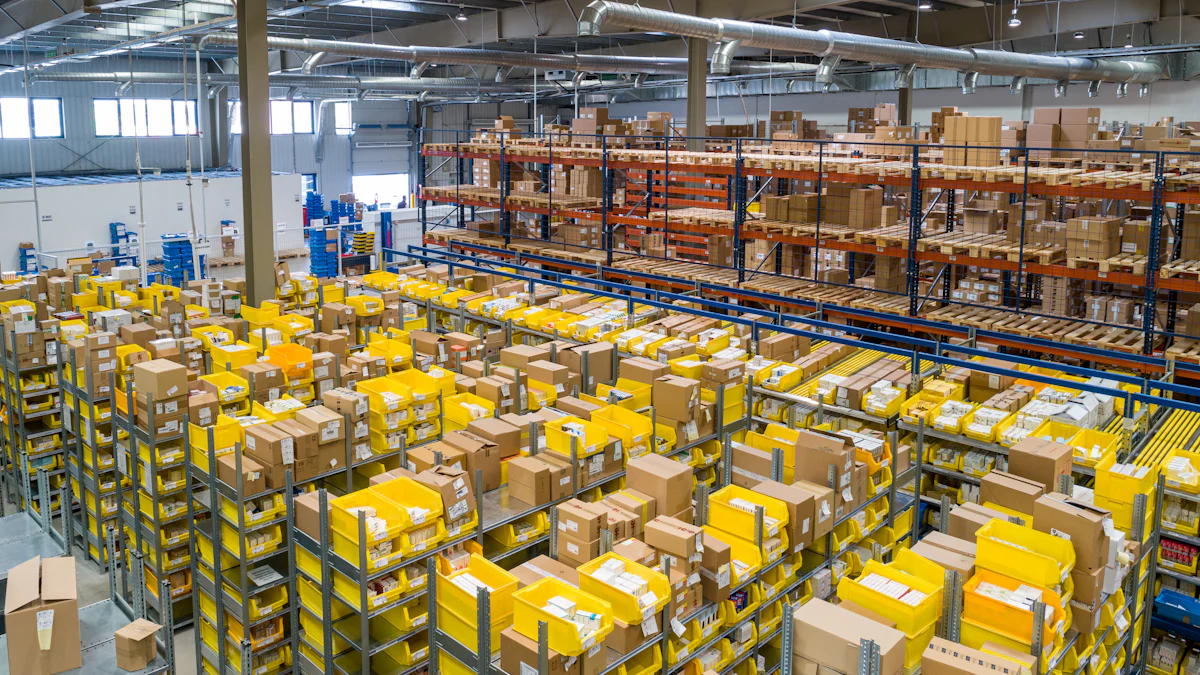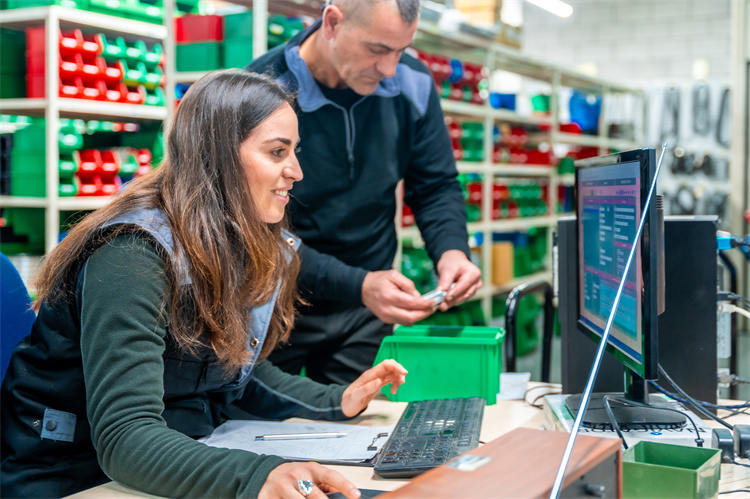Top Technologies Transforming Warehouse Automation

Warehouse automation transforms traditional operations into efficient systems. Automated warehouse technologies streamline processes and reduce costs. Labor accounts for 50% to 70% of warehousing budgets, making automation essential. Automation increases productivity by 25% and improves stock use efficiency by 30%. A study shows that picking accuracy can reach 99.99% with automated systems. Over 60% of companies plan to invest in conveyor and sortation systems. These advancements enhance operational efficiency and productivity, revolutionizing the industry.
The Evolution of Automated Warehouse Systems
Historical Context
Early Automation Technologies
The journey of automated warehouse systems began in the early 20th century. Henry Ford introduced the assembly line in the 1910s, which revolutionized manufacturing by increasing production speed and efficiency. This innovation laid the groundwork for future automation in various industries, including warehousing. By the 1950s, Automated Guided Vehicles (AGVs) emerged as a significant development. These vehicles followed wires embedded into factory floors, transporting heavy materials and reducing the physical burden on human workers. The introduction of AGVs marked a pivotal moment in warehouse automation, showcasing the potential for machines to handle tasks traditionally performed by humans.
Transition to Modern Systems
The 1960s witnessed the advent of the Automated Storage and Retrieval System (AS/RS). This system represented the first Warehouse Management System (WMS), streamlining warehousing processes and setting the stage for modern automated warehouse operations. AS/RS allowed for efficient storage and retrieval of goods, optimizing space utilization and minimizing labor costs. The evolution from manual handling to automated systems demonstrated the transformative impact of technology on warehouse operations.
Current Trends
Integration of AI and Machine Learning
In recent years, the integration of Artificial Intelligence (AI) and Machine Learning (ML) has become a cornerstone of automated warehouse systems. AI algorithms analyze vast amounts of data to optimize inventory management, predict demand patterns, and enhance decision-making processes. Machine Learning models continuously improve their accuracy by learning from historical data, enabling warehouses to operate with unprecedented efficiency. The application of AI and ML in automated warehouses leads to smarter, more adaptive systems that can respond to dynamic market conditions.
Rise of IoT in Warehousing
The Internet of Things (IoT) plays a crucial role in the modern automated warehouse landscape. IoT in warehousing devices connect various components within a warehouse, facilitating seamless communication and data exchange. Sensors and RFID tags track inventory in real-time, providing accurate information about stock levels and locations. This connectivity enhances operational visibility and enables proactive maintenance of equipment. The rise of IoT in warehousing empowers businesses to achieve higher levels of automation, resulting in improved productivity and reduced operational costs.
Key Technologies Driving Transformation in Automated Warehouses

Robotics and Automation
Autonomous Mobile Robots (AMRs)
Autonomous Mobile Robots (AMRs) play a crucial role in modern automated warehouse systems. Autonomous Mobile Robots (AMRs) navigate independently within warehouse environments, transporting items and materials efficiently. These robots reduce the need for manual handling, minimizing labor-intensive tasks. AMRs optimize travel routes and adapt to changing warehouse layouts. Integration with Warehouse Management Systems ensures seamless coordination in order fulfillment. AMRs contribute to reduced order lead times and improved accuracy. The operational efficiency of warehouses increases significantly with AMR deployment.
Collaborative Robots (Cobots)
Collaborative Robots (Cobots) work alongside human workers in automated warehouse settings. Cobots assist in tasks requiring strength, precision, or repetitive movements. These robots enhance worker safety by handling heavy items and performing intricate assembly tasks. Cobots support loading and unloading operations, improving productivity. Advanced safety features ensure safe interaction between Cobots and human workers. Cobots contribute to streamlined operations and enhanced efficiency in automated warehouse environments.
Advanced Data Analytics
Predictive Analytics for Inventory Management
Predictive analytics revolutionizes inventory management in automated warehouse systems. This technology analyzes historical data to forecast demand patterns accurately. Predictive models optimize stock levels, reducing excess inventory and stockouts. Automated warehouses benefit from improved decision-making processes. Predictive analytics enhances operational efficiency by aligning inventory with market demand. The use of predictive analytics leads to cost savings and increased profitability.
Real-time Data Processing
Real-time data processing is essential for effective automated warehouse operations. This technology enables immediate analysis of data from various sources. Real-time insights facilitate quick decision-making and responsive actions. Automated warehouses achieve higher levels of accuracy and efficiency with real-time data processing. This capability supports proactive maintenance and minimizes downtime. Real-time data processing enhances the overall performance of automated warehouse systems.
Cloud Computing and Connectivity
Cloud-based Warehouse Management Systems (WMS)
Cloud-based Warehouse Management Systems (WMS) transform automated warehouse operations. Cloud-based Warehouse Management Systems provide centralized control and visibility over warehouse activities. Cloud-based WMS integrates various automation technologies seamlessly. The flexibility and scalability of cloud solutions enhance operational efficiency. Automated warehouses benefit from reduced IT infrastructure costs and improved data accessibility. Cloud-based WMS supports dynamic inventory management and efficient resource allocation.
Enhanced Connectivity through 5G
Enhanced connectivity through 5G technology revolutionizes automated warehouse environments. 5G networks enable faster and more reliable communication between devices. Automated warehouses experience improved data transfer speeds and reduced latency. This connectivity supports real-time monitoring and control of warehouse operations. 5G technology enhances the integration of IoT devices and robotics. Automated warehouses achieve higher levels of automation and productivity with 5G connectivity.
Benefits of Implementing Advanced Technologies in Automated Warehouses

Increased Efficiency and Productivity
Reduction in Manual Labor
Automated warehouse technologies significantly reduce the need for manual labor. Machines handle repetitive tasks, allowing workers to focus on more complex activities. This shift increases overall productivity. Employees can engage in strategic roles that require human intelligence. The reduction in manual labor also minimizes fatigue-related errors. Automation ensures consistent performance without breaks. Businesses experience a boost in operational efficiency.
Faster Order Fulfillment
Order fulfillment speeds up with automated warehouse systems. Machines quickly sort and transport items. Automated processes eliminate delays caused by human intervention. Real-time data processing optimizes picking routes. This technology reduces order lead times. Customers receive their products faster. Enhanced speed leads to higher customer satisfaction. Businesses gain a competitive edge in the market.
Improved Accuracy and Safety
Minimization of Human Error
Automated warehouse systems enhance accuracy by minimizing human error. Machines follow precise instructions without deviation. Predictive analytics improve inventory management. Accurate demand forecasting prevents overstock and stockouts. Automated systems ensure correct item placement and retrieval. The accuracy rate in automated warehouses reaches impressive levels. Businesses benefit from reduced returns and increased trust from customers.
Enhanced Workplace Safety
Workplace safety improves with automation in warehouses. Machines handle hazardous tasks, reducing risks for employees. Collaborative robots assist in lifting heavy loads. This assistance prevents workplace injuries. Automated systems maintain a controlled environment. Sensors detect potential hazards and alert operators. Enhanced safety measures create a secure working atmosphere. Employees feel more confident and motivated in their roles.
Technology has profoundly transformed warehouse automation. Robotics and AI have redefined operational efficiency. Automation in warehouses enhances productivity and reduces costs. Kelton Kosik, Head of Supply Chain at Ware2Go, emphasizes that automation elevates human capabilities rather than replacing them. The future will see AI and robotics coexisting with humans. This shift requires workers to engage in intellectual tasks. Robotics could reduce logistics costs by up to 40% by 2025. Businesses must adopt these technologies to remain competitive. Embracing innovation ensures sustained growth and success in the evolving industry landscape.
See Also
Automated Future: Advantages of High-Tech Manufacturing Warehouses
Enhancing Efficiency: Understanding Robotic Automation in Warehousing
The Importance of Warehouse Automation for Your Business
